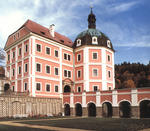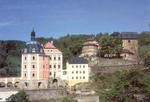Becov
 Becov nad Teplou is situated in beautiful scenery in the valley of the Tepla River between Karlovy Vary and Marianske Lazne, right in the heart of the Slavkovsky les nature reserve. The surroundings of Becov rank among the most wonderful in the Karlovy Vary region. You can find fascinating scenery, a clean environment and the healing silence of deep forests here.
Becov nad Teplou is situated in beautiful scenery in the valley of the Tepla River between Karlovy Vary and Marianske Lazne, right in the heart of the Slavkovsky les nature reserve. The surroundings of Becov rank among the most wonderful in the Karlovy Vary region. You can find fascinating scenery, a clean environment and the healing silence of deep forests here.
The beginning of Becov is closely connected with an important trade route connecting Bohemia and Germany. It ran in the direction from Zlutice to Cheb. A fortified stronghold with a guard and customs function was built on a piece of rock towering over the Tepla River to protect the route in the 13th century. In 1387 king Wenceslas confirmed the Bors of Ryzmburk's right to collect customs fees in Becov and Drazov. Another important factor in the development of Becov from the 13th to 16th century was ore mining in the central part of the Slavkovsky les Mountains (gold, silver, and pewter). Pewter mining especially was of European importance and brought both an economic and a cultural boom to this part of the country. Noble families - the Ryzmburks of Osek and the Pluhs of Rabstejn, played the key part in the exploitation of mineral resources. Pewter mining reached its height in the first half of the 16th century, then is slowly started to decline and this process was completed by the Thirty Years' War.
The search for new sources of income resulted in the boom in the crafts and guilds. Numerous specific crafts appeared in the Becov region (pewtering, shearing, tanning, millinery, etc). A remarkable specialty of the cultural life in the Becov region after 1650 was the development of a folk music tradition. Many communities became famous for their gifted musicians (Becov, Javorna, Drazov, Chodov, and Nova Ves).
The appearance of Becov and the neighboring places changed considerably at the time of the Baroque, i.e. in the 17th and 18th centuries. Numerous buildings were rebuilt in the Baroque style. Only the ground plans and nuclei of the houses have preserved their Gothic and Renaissance origin. Reconstruction particularly affected the castle of Becov and the St. George Church. New Baroque churches and chapels were built e.g. in Javorna, Nova Ves, Drazov and Dolni Hluboka.
The 19th century brought the development of road and railway transport to Becov. Postal services made considerable strides as well. In the 18th and 19th centuries traditional pewtering, button-making, leather goods manufacturing and hop trading flourished. Most people in the country lived from cattle breeding (especially sheep-breeding) and farming. A small factory producing sulfuric acid (Vitriolka) was established in the neighborhood of Chodov. The first small factories appeared in about 1800. The first Czech porcelain factory was founded in the neighboring Horni Slavkov in 1792. Trial production of porcelain had started, however, in 1789, i.e. three years before, in the Haje village near Becov. The vast forests of the Becov region provided numerous job opportunities, which represented an important economic factor of the estate from as early as the Middle Ages. In the first half of the 19th century the local musical tradition was enriched with the work of the teacher Karl Veit. A renowned musical school was founded in Becov in 1887. Pupils from the whole of northwest Bohemia studied there.
The 20th century brought another improvement of transport and postal services. The railway line leading from Krasny Jez to Loket was completed in 1901. Remote villages were gradually connected to the national grid. At the close of the 19th century, the beauties of nature in the Slavkovsky les Mountains started to be discovered and admired by tourists and natural historians.
World War I brought a decline in the economy to this part of the country, as well as poverty and grief at the loss of the loved ones. Tens of monuments to the war dead from the years 1914 to 1918 were built. After the war the last remains of the specific folk culture started to die away quickly. The typical half-timbered houses disappeared. The old, architecturally valuable country houses were replaced by uniform buildings, which copied the town pattern.
The end of World War II had far-reaching consequences for the whole region and its inhabitants. German inhabitants were evacuated and Becov and its neighborhood were re-settled by Czech people from inland. Remote parts of the Becov region attracted only few settlers as the connection and supply services were bad. There were only minimal job opportunities there. Many places became completely deserted after the Germans had left.
The boom in uranium mining in the neighborhood of Horni Slavkov (Krasno, Leznice, Krasny Jez) brought a new revival after 1950. Peaceful times started for the Slavkovsky les Mountains only after the uranium deposits had been exploited (in about 1960). At that time attention was directed particularly at forestry and agriculture. The beauties of the local nature were gradually "re-discovered" for recreation. After 1968 the Becov region became a popular holiday resort. There are several small factories in Becov (e.g. Elektro). The local trout hatchery has won a good reputation. In 1974 the Slavkovsky les nature reserve, which includes the whole Becov region, was established. Becov-on-Tepla is an ideal starting point for trips to the nature reserve. A green marked footpath from Javorna to Prameny runs through the town. The present Becov is trying to get a new, attractive "image" which would increase the number of visitors to the town. For this purpose the historical center of the town is gradually being repaired. Its gem, a Baroque castle, was opened to the public in 1996. Since the summer of 1997 the most attractive exhibit and magnet of the castle has been the valuable St. Maurus reliquary dating from the 12th century, a unique Romanesque sight of European importance.
 Guide
Guide 


